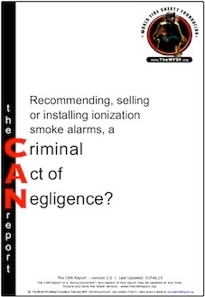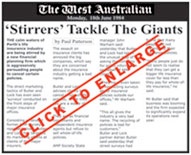




If you live in Australia or New Zealand (whether you own or rent), chances are your life is at needless risk because almost every Australasian home (whether new or old) will have the ‘dangerously defective’ ionization type of smoke alarm installed - and no one wants to admit they are not safe (remember the tobacco industries, ‘no causal link between nicotine and cancer’?).
Since June 2006, the official position on smoke alarms, of ALL Australasian Fire Brigades, is that ALL homes are fitted with photoelectric smoke alarms (see position statements below).
Ionization ‘smoke’ alarms are mislabelled and misrepresented. Whilst they do detect flames, Australian Government testing shows they are very poor at detecting visible smoke. Moreover, ionization detection technology is highly susceptible to false alarms and an unacceptably high number of people disconnect or disable them.
As incredible as it may seem, despite going off when we’re cooking, the ionization alarms we have in our homes do not safely detect smoke from the smouldering type of fires that so often kill (see the ‘Smoke Alarm Recall’ film Here > > >).
Tragically, because this vital, life-saving information has not gotten through to most fire fighters, lives will continue to be needlessly lost until the truth is finally exposed.
So why haven’t we been told? We believe it is because our Fire Brigades and other authorities have been relying on (mis)information about smoke alarms from big U.S. agencies. It has been alleged that these agencies have misled the American public and, in the words of Mr Richard Patton, US, Fire Protection Engineer,

“Given the weight of evidence
surrounding the efficiency of
different smoke alarm types,
it is not enough that standards,
regulatory, and fire safety
organisations recommend
photoelectric smoke alarms -
they have a duty of care to warn
the public of the known, life-threatening limitations of ionization smoke alarms.”




The Smoke Alarm Disclosure Letters
(For Australian & New Zealand Residents Only)

Karl Westwell
CEO, Co-Founder
The World Fire
Safety Foundation
Tauranga, New Zealand
August, 2009
A Special Duty of Care
David Isaac
Standards Australia smoke alarm committee
FP-002 member,
August, 2006.

“Ionization smoke alarms are
dangerous because they lull
people into a false sense of security when cooking toast but
often fail in smouldering fires.”
“Ionization Smoke
Alarms are Dangerous”
“For over ten years we’ve been trying to get the truth to Fire Fighters about the dangerously
defective ionization smoke alarms installed in hundreds of millions of homes around the world.
You have a right to find out the facts about the smoke alarms in your home so you have the
opportunity to properly protect your family from fire.”

from, Stop the Children Burning which appeared on national Australian TV, September, 2004.
“their corruption has been exported to Australia and to New Zealand.”
“Fire Fighter’s haven’t
been told the truth”

“Fire fighters haven’t been told
the truth. Watch ‘Smoke Alarm
Recall’ and find out the facts
for yourself.”
Peter Canon
Volunteer Fire Fighters Association, NSW
August, 2006.
“Will these Letters Work?”
Frequently Asked Questions:
What if my smoke alarms are not listed?
Only ionization smoke alarms tested under Australian Standard 3786-1993 (AS3786) are listed.
Why do you only list smoke alarms tested under AS-3786-1993?
The Smoke Alarm Disclosure Letter is only sent to smoke alarm suppliers that have ionisation smoke alarms listed in the Australian Scientific and Industrial Research Organisation (CSIRO) ActivFire Register of Fire Protection Equipment (extract: smoke alarms). The smoke alarms contained within the ActivFire product list have been independently evaluated and verified as conforming to Australian Standard AS3786.
Why do you only list ionization smoke alarms?
The scientific test data held by the CSIRO shows that ionization smoke alarms do not detect (visible) smoke in pre-flaming/smouldering stage of fires until 2 - 3 times the maximum safe limit (i.e. 20% light obscuration per metre) specified in the standard. However, due to a flaw in AS3786, despite the requirement they be subjected to the test, ionization smoke alarms are not required to pass the (visible) smoke test. CSIRO have advised that all ionization smoke alarms, if required to pass the (visible) smoke test, would have failed.
Can't you just get this information from CSIRO?
No. CSIRO believe that releasing data on individual alarms would be in breach of its testing agreement with the supplier.
Why write to the supplier?
AS3786 requires that ionisation smoke alarms be subjected to the (visible) smoke test, it also requires that the percent light obscuration per metre be recorded and that this test data be passed on to the supplier. We believe it is your right to know at what level the model of smoke alarm/s in your home activated during the testing procedure.
Why is this so important?
Your life and the lives of your loved ones may one day depend upon the smoke alarm/s in your home activating in a timely manner. The majority of people who die in a home fire do not die from burns; they die from smoke inhalation. Most people who die in fires, die at night. The most common type of fire that kills smoulders prior to ignition/busting into flames. The length of time a fire smoulders may vary from as little as a few minutes to several hours or even longer. Getting early warning during the smouldering stage of a fire, when (visible) smoke is generally produced, is vital to safe escape. The current Australian Standard specifies the maximum safe limit for photoelectric smoke alarms to activate is 20% smoke (i.e. 20% light obscuration per metre). CSIRO evidence show Ionization smoke alarms do not activate until two to three times the maximum safe limit specified in the standard.
What are Standards Australia doing about this?
Standards Australia FP-002 Smoke Alarm Committee have acknowledged the standard is flawed and published a draft amendment to the standard. However, Standards are not legally binding until they are called into legislation. At present, the proposed amendment to the standard is being blocked by the Australian Building Codes Board (ABCB).
What are our Fire Brigades doing about this?
In June, 2006, the Australasian Fire and Emergency Service Authorities Council (AFAC), the peak representative body for all fire services in Australia and New Zealand, adopted the official position, "That all residential accommodation be fitted with photoelectric smoke alarms." AFAC’s position warns that, "Ionisation smoke alarms may not operate in time to alert occupants early enough to escape from smouldering fires."
What can I do about this?
Firstly, if you have ionisation smoke alarm/s are they are listed in the ActivFire register, send a Smoke Alarms Disclosure Letter using our online form. It takes less than three minutes! Secondly, replace the ionisation smoke alarms in your home with photoelectric smoke alarms so you can properly protect your family from fire.
To send your Smoke Alarm Disclosure Letter, click Here > > >
In 2006, the Australian Standards FP002 committee investigated the testing requirements for smoke alarms in Australia. They discovered that if ionization alarms
were required to pass the same Australian Standards smoke sensitivity criteria as photoelectrics smoke alarms they would fail


The CAN Report






Background Information

(c) Copyright 2010 The World Fire Safety Foundation | Last Updated: 16 April, 2011 | Privacy Policy | Disclaimer | Search WFSF site
For errors on, or suggestions for this ‘sadlinfo’ webpage, contact the WFSF WebMaster | Supporters | About | Media
